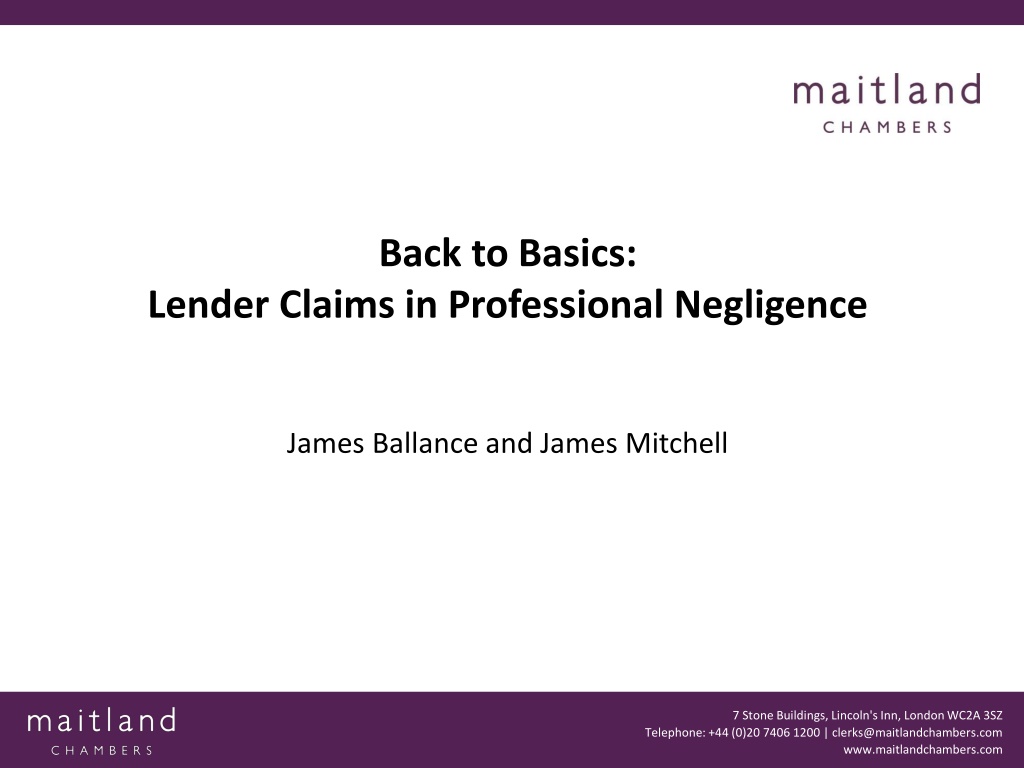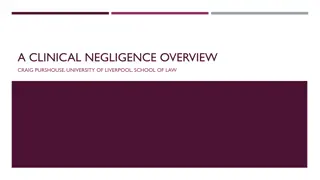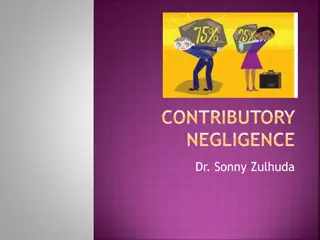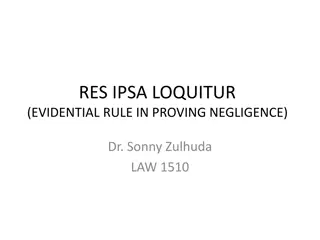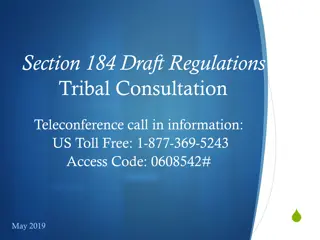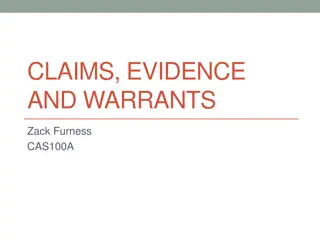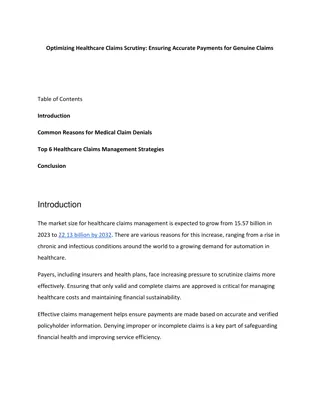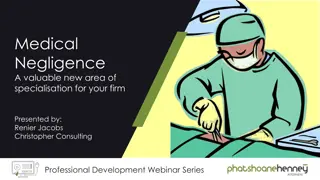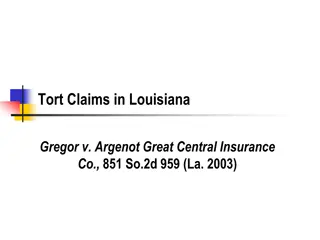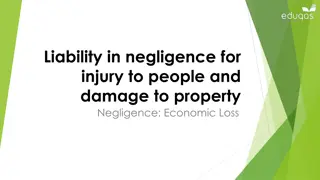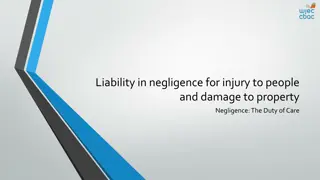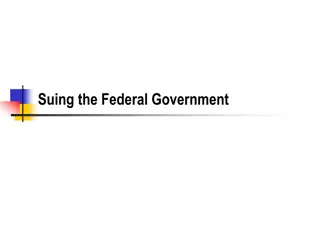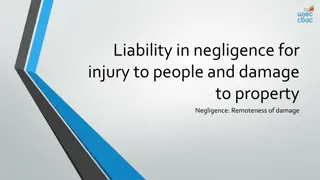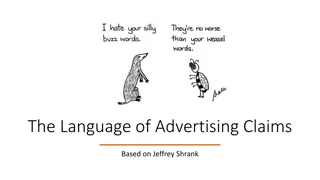Understanding Lender Claims in Professional Negligence Cases
Exploring lender claims in professional negligence, covering topics like breaches of duty, liability of valuers, establishing liability issues, and more. It discusses the duties and responsibilities of valuers, the potential liabilities they face, and how lenders can rely on valuations. Key cases and legal standards are highlighted to provide insights into this complex area of law.
Download Presentation

Please find below an Image/Link to download the presentation.
The content on the website is provided AS IS for your information and personal use only. It may not be sold, licensed, or shared on other websites without obtaining consent from the author. Download presentation by click this link. If you encounter any issues during the download, it is possible that the publisher has removed the file from their server.
E N D
Presentation Transcript
Back to Basics: Lender Claims in Professional Negligence James Ballance and James Mitchell 7 Stone Buildings, Lincoln's Inn, London WC2A 3SZ Telephone: +44 (0)20 7406 1200 | clerks@maitlandchambers.com www.maitlandchambers.com
Lenders Remedies Secured Claims Possession LPA Receivers Power of sale Unsecured Claims Borrower Guarantors Prof Neg Claims Valuers Solicitors 7 Stone Buildings, Lincoln's Inn, London WC2A 3SZ Telephone: +44 (0)20 7406 1200 | clerks@maitlandchambers.com www.maitlandchambers.com
Professional Negligence Category Error? Negligence / breach of duty of care Breach of contract or retainer Breach of warranty of authority Breach of undertaking Breach of trust Breach of fiduciary duty 7 Stone Buildings, Lincoln's Inn, London WC2A 3SZ Telephone: +44 (0)20 7406 1200 | clerks@maitlandchambers.com www.maitlandchambers.com
Valuer Claims: Bases of Liability Breach of contract / retainer Nature of duty? Depends on terms of contract of engagement Invariably under implied (if not express) duty of care when providing professional services: Kenney v Hall, Pain & Foster [1976] 2 EGLR 29, 33 Statutory duty: s.13 Supply of Goods and Services Act 1982 (still applicable in non-consumer cases) Duty to care at common law Duty of care will ordinarily arise in tort even in the absence of a contract Concurrent cause of action: BBL v Eagle Star [1995] 2 QB 375, 403-404 Standard of duty? Bolam test: valuation is an art not a science; conclusion negligent only if no reasonably competent valuer exercising reasonable care could have reached it. 7 Stone Buildings, Lincoln's Inn, London WC2A 3SZ Telephone: +44 (0)20 7406 1200 | clerks@maitlandchambers.com www.maitlandchambers.com
Establishing Liability: Potential Issues A strict duty to value subject property? Platform Funding Ltd v Bank of Scotland plc [2009] QB 426. Valuer misled by borrower into valuing completed dwelling instead of empty plot on same street. Valuation certified that the property has been inspected by me and the valuation was a fair indication of market value for mortgage purposes. Held: valuer had warranted that he had inspected the subject property, resulting in strict liability for breach of that duty Can a lender rely on a valuation commissioned by the borrower? Contractual duty if lender asks for a retype ; otherwise foreseeability of lending/syndication may result in assumption of responsibility Surveyor may seek to exclude tortious duty of care by disclaimer Omega Trust Co Ltd v Wright, Son & Pepper [1997] PNLR 424: valuation to Lender A could not be relied on by Lender B, who had relied on the valuation when Lender A could not fund all the advance Relevance of thebracket of reasonably competent valuations: Capita v Driver Jonas [2011] EWHC 2336:There is a permissible margin of error (bracket); a negligent valuation will only be wrong if the end result is outside the bracket (even if the valuation contains defective reasoning) Valuer can potentially escape liability even outside the bracket; or be liable for negligent advice within it 7 Stone Buildings, Lincoln's Inn, London WC2A 3SZ Telephone: +44 (0)20 7406 1200 | clerks@maitlandchambers.com www.maitlandchambers.com
Solicitor Claims: Bases of Liability Breach of contract / retainer Terms of engagement? Lender s letter of instruction (esp. scope of duty : e.g. Spire Property Development LLP v Withers LLP[2022] EWCA Civ 970) UK Finance Mortgage Lenders Handbook (formerly CML Handbook) Implied duty of care at common law or under s.13 of 1982 Act When does duty arise? Retainer, not initial inquiry: Miller v Irwin Mitchell LLP [2022] EWHC 2252 (Ch). Duty of care in tort Concurrent duty will arise on established principles Solicitors may assume responsibility to non-client lenders in tort if aware that their advice/representation is being relied on by others, e.g. in the case of syndication: compare Omega Trust Mortgage Lenders Handbook Para 1.4: The standard of care . is that of a reasonably competent solicitor acting [for] a mortgagee. Para 2.3: duty to report and advise; compare para 5.5.1: professional judgment on planning matters Paras 3.1: express obligations in relation to verification of identity Para 5.1: immediate report if vendor registered for less than 6 months Para 6.4.4: report cashback / non-cash incentive 7 Stone Buildings, Lincoln's Inn, London WC2A 3SZ Telephone: +44 (0)20 7406 1200 | clerks@maitlandchambers.com www.maitlandchambers.com
Solicitors Claims: extending liability beyond contract/tort Breach of fiduciary duty Solicitor owes duty of single-minded loyalty, good faith and confidence to his client Handbook: paras 1.13 to 1.16 Bristol & West Building Society v Mothew [1998] Ch 1: intentional preference of borrower s interests Breach of trust Client monies held on trust Handbook: para 10.7. You must hold the loan on trust for us until completion Not every breach of retainer will result in breach of trust: Mothew [1998] Ch 1 But where funds a released without genuine completion there is a breach of trust: P&P Property Ltd v Owen White & Catlin [2018] EWCA Civ 1082 Breach of warranty of authority Action against vendor s solicitors for warranting authority of true proprietor: P&P Property Ltd (above) Breach of undertaking Code for Completion by Post; undertakings by V s solicitors to B s solicitors/purchaser. And mortgagee? 7 Stone Buildings, Lincoln's Inn, London WC2A 3SZ Telephone: +44 (0)20 7406 1200 | clerks@maitlandchambers.com www.maitlandchambers.com
Problem Questions 1. A surveyor mistakenly values plot 3 instead of plot 4 (which is at a less advanced stage of build). He certifies he has exercised reasonable care in valuing the subject property . Strict liability or negligence? A valuation produced for Lender A is subject to disclaimer of liability to any third party. Lender A informs the valuer that they will be sharing the valuation with Lender B with a view to syndicating the loan. The valuer does not object. Is there an assumption of responsibility; and does the disclaimer still apply? Solicitors instructed to act for both borrower/purchaser and mortgage lender on usual terms. The firm is told that the balance of the purchase price is coming from a third party who will be granted a second charge after completion. Separately the firm discovers the vendor bought the property only 3 months ago for 75% of the new purchase price. Does failure to report these matters sound in negligence or breach of fiduciary duty? Solicitors are instructed to act for a lender on a residential purchase. They carry out their duties with reasonable care and skill and procure the usual undertakings from the vendor s solicitors, who in fact are instructed by a fraudster. V s solicitors pay away the purchase monies (including the mortgage loan) thinking they hold a valid transfer. Can the lender bring a claim against its own, or V s solicitors? 2. 3. 4. 7 Stone Buildings, Lincoln's Inn, London WC2A 3SZ Telephone: +44 (0)20 7406 1200 | clerks@maitlandchambers.com www.maitlandchambers.com
Possible Answers 1. A question of construction. Has the surveyor certified only that he has exercised reasonable care and skill in trying to identify the plot, or that in valuing the actual plot, he has exercised reasonable care and skill? Probably the former. Unlike Omega, the surveyor here has been told of the possibility/likelihood of syndication, so a duty of care is more likely to be implied. By not objecting, valuer may be said to have waived reliance on the disclaimer. Has Lender B been told of the valuer s non-objection? Clear express obligations to report such matters to the lender, so a breach of contract; and also a breach of contract/tortious duty of care. Whether there is a breach of fiduciary duty depends on whether the solicitors has consciously preferred the interests of the borrower. Conduct need not be dishonest but must involve an intentional preference. There is a clear breach of trust in light of the authorities on what constitutes completion for the purposes of the Handbook and Code of Completion; though s.61 Trustee Act 1925 may rescue an innocent solicitor. The undertakings given by V s solicitors are enforceable by B or its solicitors; rather less clear on the wording of the Code whether a mortgagee is also intended to benefit. 2. 3. 4. 7 Stone Buildings, Lincoln's Inn, London WC2A 3SZ Telephone: +44 (0)20 7406 1200 | clerks@maitlandchambers.com www.maitlandchambers.com
Damages Measure of damages follows from the cause of action: Contract: expectation damages (in the position would have been if contract had been performed) or reliance damages Tort: put the claimant in the position they would have been had the wrong not occurred Breach of Trust / Equitable claims: Equitable Compensation / Taking an account - look at AIB Group v Mark Redler & Co Solicitors [2015] AC 1503 for a starting point on breach of trust claims by lenders against solicitors (but not covered in this talk). For a lender s negligent valuation case the basic measure of damages/loss is to put C in the position they would have been had the duty of care been fulfilled, by comparison with the position C is actually in: The basic comparison is between (a) the amount of money lent by the [claimant], which he would still have had in the absence of the loan transaction, plus interest at a proper rate, and (b) the value of the rights acquired, namely the borrower s covenant and the true value of the overvalued property : per Nykredit Mortgage Bank Plc v Edward Erdman Group Ltd (No 2) [1997] 1 WLR 1627, 1631 (per Lord Nicholls) Topics in this section (in the context of negligence claims): Update on SAAMCO Damages based on hypotheticals: loss of chance and loss of profits Benefits from mitigation or otherwise reducing damages 7 Stone Buildings, Lincoln's Inn, London WC2A 3SZ Telephone: +44 (0)20 7406 1200 | clerks@maitlandchambers.com www.maitlandchambers.com
Damages in Negligence 6 questions to ask when considering whether something is recoverable in damages in negligence: 1. Is the harm actionable in negligence (the actionability question)? 2. What risks of harm to C has the law imposed a duty on D to take care (scope of duty question)? 3. Did D breach their duty by their act or omission (breach question)? 4. Is the loss the consequence of D s act or omission (the factual causation question)? 5. Is there a sufficient nexus between a particular element of the harm for which C seeks damages and the subject matter of D s duty of care (the duty nexus question)? 6. Is the element of harm for which damages is sought irrecoverable because it is too remote, or a different intervening cause (i.e. by a third party), or because C has mitigated or failed to mitigate its loss (the legal responsibility question)? Manchester Building Society v Grant Thornton UK LLP [2021] UKSC 20; [2021] 3 WLR 81 at [6] per Lord Hodge and Lord Sales and Khan v Meadows [2021] UKSC 28 at [28]. 7 Stone Buildings, Lincoln's Inn, London WC2A 3SZ Telephone: +44 (0)20 7406 1200 | clerks@maitlandchambers.com www.maitlandchambers.com
The SAAMCO Cap The classic example: Lender (L) relies on valuer s (V s) negligent valuation when advancing sums under a loan. The valuation of the property was 2m, but its true value only 1.5m. Had the true value been known the 1.75m loan would not have been advanced. At the time the property was sold, it was only worth 1m. The loss could be: 1m the difference between the valuation and what was recovered; 750,000 the shortfall on the recovery of the loan; or 500,000 the difference between the valuation and true value of the property. The loss is only 500,000: that is because the scope of the valuer s duty is only advising on what the present value of the property is and is not warranting or advising that the property won t fall: see South Australian Asset Management Corporation [1997] AC 191. The SAAMCO principle applies to all claims in negligence, not just valuation cases. E.g: Hughes Holland v BPE Solicitors [2018] AC 599 which concerned a negligently drafted loan agreement that confirmed C s (a property developer) incorrect understanding that a loan he was advancing was for the costs of the development. The development failed and D solicitors were sued in negligence. As D s retainer was limited to drafting the documentation, D were not responsible for all of the losses from the development. 7 Stone Buildings, Lincoln's Inn, London WC2A 3SZ Telephone: +44 (0)20 7406 1200 | clerks@maitlandchambers.com www.maitlandchambers.com
SAAMCOs Operation in novel cases Scope of Duty / Duty nexus test: the scope of duty of care assumed by a professional adviser is governed by the purpose of the duty, judged on an objective basis by reference to the reason why the advice is being given : MBS v GT at [13] in the case of negligent advice given by a professional adviser one looks to see what risk the duty was supposed to guard against and then looks to see whether the loss suffered represented the fruition of that risk : MBS v GT at [17] Counter-factual analysis (of what would have happened had the information provided been correct): the counterfactual assumes that the claimant would behave as he did in fact behave and asks, whether, if the advice had been correct, the claimant s actions would have resulted in the same loss. By this means, the court can ascertain the loss which is attributable to that information being wrong : Khan v Meadows at [53] However, this is not the test and should only be applied as a cross-check: MBS v GT at [23]-[27] 7 Stone Buildings, Lincoln's Inn, London WC2A 3SZ Telephone: +44 (0)20 7406 1200 | clerks@maitlandchambers.com www.maitlandchambers.com
Loss of a Chance The harm or damage suffered in professional negligence cases often involve hypothetical questions of what would have happened had the negligence not occurred. How does one prove those hypotheticals? Depends on who controls what would have happened: If in control of the claimant: need to show what would have happened on the balance of probabilities (an all or nothing assessment). If in control of a third party: need to show a real or substantial chance that some action dependent on that third party would have occurred (for which then the Court will assess the lost chance of that outcome). See Perry v Raleys Solicitors [2020] AC 352 at [20]; Allied Maples v Simmons & Simmons [1995] 1 WLR 1602; Wellesley Partners LLP v Withers LLP [2016] Ch 529 (CA) at [100] Often need to combine both stages: i.e. if the lost chance is negotiating a different term in the contract you would need to show (i) the claimant would have sought to renegotiate on the balance of probabilities; and (ii) that there was a real or substantial chance that there would have been a successful renegotiation with the third party. 7 Stone Buildings, Lincoln's Inn, London WC2A 3SZ Telephone: +44 (0)20 7406 1200 | clerks@maitlandchambers.com www.maitlandchambers.com
Loss of Profits and Interest in negligent valuation cases For claimant lenders who fall have claims for professional negligence the possible consequential losses may raise the issue of loss of profits. Loss of profits from interest that would have been charged or in fact had been charged under any loan agreement would not be recoverable: Swingcastle Ltd v Gibson [1991] 2 AC 223, p.238F-H. Loss of profits from making another profitable loan: theoretically can be claimed by almost impossible to prove Mortgage Express v Countywide Surveyors [2016] EWHC 1830 (Ch) at [53]. Simple interest under s.35 of the Senior Courts Act 1981 (or s.69 of the County Courts Act 1984). The rate of interest may depend on the cost of borrowing of a lender, with a slight uplift to reflect the fact that simple interest and not compounded: Mortgage Express v Countrywide Survyeors at [56]-[60]. The practice point is to have some indication of what the actual compounded loss would be for cost of borrowing and compare against various simple interest rates. This line of authority may not apply outside of the lender context, and in fact is largely concerned with questions of causation rather than assessment of damages: see Barrowfen Properties Limited v Patel [2022] EWHC 1601 at [76] 7 Stone Buildings, Lincoln's Inn, London WC2A 3SZ Telephone: +44 (0)20 7406 1200 | clerks@maitlandchambers.com www.maitlandchambers.com
Collateral Benefits / Mitigation A claimant must take reasonable steps to mitigate their losses. While they can claim the costs of taking those steps of mitigation, the corresponding benefit obtained by taking steps of mitigation is taken into account to reduce the damages. The security obtained and enforced against. Repayments of previous facilities from advances from a second facility: Tuita International Ltd v De Villiers Surveyors Ltd [2017] 1 WLR 4627 at [12]-[13]. Valuing the Personal Covenant: Important for assessment of the basic measure of damages in negligent valuation cases: see Nykredit (above). Often a crucial factor in determining from when there was loss (thus completing the cause of action in negligence for limitation purposes) Can take into account some hindsight: Canada Square v Kinleigh Folkard & Haward [2016] PNLR 3 (Central London County Court) at [26]-[27] To value the covenant often look to see what shortfall there was on security at the time and whether value of personal covenant was sufficient to make up that difference: Canada Square at [35] Reality may be in terms of affect on quantum at trial may be limited, because likely to be only looking at professional negligence if the borrower has broken his covenant to repay. 7 Stone Buildings, Lincoln's Inn, London WC2A 3SZ Telephone: +44 (0)20 7406 1200 | clerks@maitlandchambers.com www.maitlandchambers.com
Problem Question D is a firm of conveyancing solicitors who acted on behalf of C (a lender) in a transaction to advance money for the purchase of a property (an modest suite of offices) in January 2019 which is to be converted into a shop by the borrower who has borrowed funds to do this. D negligently failed to advise on the existence of a restrictive covenant which prevents the borrower from running his shop at the property. C lends 1,000,000 to be secured over the property and would not have lent the money had it been properly advised as to the existence of the restrictive covenant1. The property was worth 1.25m in 2019 (and the valuation obtained was not negligent). Subsequently the restrictive covenant was enforced, and as a result of which the borrower s business was shut down and the borrower defaulted. In the meantime the value of the property has decreased and is now worth only 600,000 (a reduction of 650,000; 150,000 attributable to the fact that the property has been converted to a shop which cannot be used without renovation and 500,000 by reference to falls in market prices for commercial property since the transaction because of Covid- 19 and changing habits in the locality). What are C s losses? Would the answer be different if the borrower had defaulted due to Covid-19, and the restrictive covenant issue was only spotted when seeking to enforce against the security? What impact would there be if the borrower had a personal guarantee given by a director of that company? 1 In a real case this causation point is likely to be more nuanced as it may be said what would have happened is (i) there would have been a negotiation to release the restrictive covenant led by the borrower or (ii) that C would have found another property nearby on which sums would have been lent on. 7 Stone Buildings, Lincoln's Inn, London WC2A 3SZ Telephone: +44 (0)20 7406 1200 | clerks@maitlandchambers.com www.maitlandchambers.com
Possible Answers C s losses: It could be said that the scope of duty / duty nexus question would mean that the losses are only 150,000. However, the reason the business failed and repayment not made was because of the very issue on which C was supposed to advise. Seems that a good case to argue 650,000 is the loss here (and distinguishable from the ordinary valuation type of cases). If the reason why the business failed was not to do with the restrictive covenant, then it seems that the scope of duty principle would certainly bite. All that has been lost, attributable to D s negligence, is 150,000. Should the reason why the business failed in this example make a difference? Would take into account any recovery from the personal guarantee; may also be relevant to value the strength of that covenant for limitation purposes. 7 Stone Buildings, Lincoln's Inn, London WC2A 3SZ Telephone: +44 (0)20 7406 1200 | clerks@maitlandchambers.com www.maitlandchambers.com
Defences: Section 61 of the Trustee Act 1925 If it appears to the court that a trustee, whether appointed by the court or otherwise, is or may be personally liable for any breach of trust, whether the transaction alleged to be a breach of trust occurred before or after the commencement of this Act, but has acted honestly and reasonably, and ought fairly to be excused for the breach of trust and for omitting to obtain the directions of the court in the matter in which he committed such breach, then the court may relieve him either wholly or partly from personal liability for the same. A discretionary statutory ground to relieve a defendant in claims for breach of trust. Does not apply to other causes of action against trustees (e.g. a trustee who breaches a contract). The requirement of acting reasonably is often attacked. The conduct said to be unreasonable needs to have some element of causative connection will usually have to be shown but the test should not be over-mechanistic : Santander UK v RA Legal Solicitors [2014] PNLR 20 at [28]-[29]. Second stage is to consider if the Defendant ought reasonably be excused in all the circumstances. The Court considers the effect on the trustee and the beneficiary; it may depend on identity of the beneficiary (institutional lender vs private purchaser): Santander UK v RA Legal Solicitors at [33]. May even depend on insurance position: see P&P Property Ltd v Owen White & Catlin LLP [2019] Ch 273 (CA) at [110] (note Gloster LJ dissented on this point at [125(iv)]). 7 Stone Buildings, Lincoln's Inn, London WC2A 3SZ Telephone: +44 (0)20 7406 1200 | clerks@maitlandchambers.com www.maitlandchambers.com
Defences: Limitation Accrual of the cause of action: Contract when the contract was breached the cause of action is complete (whether or not there is damage at that point in time); Negligence usually when actionable damage has been suffered (which may be some time after the breach of duty). This can be a difficult question. In case of negligent valuations it is the date on which the value of the lender s security and the personal covenant of the borrower is less than the amount owed by the borrower: see Nykredit Mortgage Bank Plc [1997] 1 WLR 1627 The cause of action in negligence only, may be extended if the damage was latent under section 14A of the Limitation Act 1980 for a period of 3 years after the date which the claimant first had the knowledge required for bringing an action for damages and a right to bring such an action. Extensions to the cause of action if it is a claim based on fraud (s.32(1)(a) of the Limitation Act 1980) or where a relevant fact of the cause of action was deliberately concealed by the defendant (s.32(1)(b)). Time does not start to run until the fraud or concealment could have been discovered with reasonable diligence. Claims for breach of trust or other equitable claims have different rules and may be a case of looking at s.21 of the Limitation Act, applying the contract/tort rules by analogy or simply using the doctrine of laches. 7 Stone Buildings, Lincoln's Inn, London WC2A 3SZ Telephone: +44 (0)20 7406 1200 | clerks@maitlandchambers.com www.maitlandchambers.com
Defences: Contributory Negligence Where a person suffers damage as the result partly of his own fault and partly of the fault of any other person or persons the damages recoverable in respect thereof shall be reduced to such extent as the court thinks just and equitable having regard to the claimant s share in the responsibility for the damage : s.1(1) Contributory Negligence Act 1945. Note that where the SAAMCO Cap is invoked, contributory negligence is assessed on the whole of the basic loss and then the cap is applied: see Platform home Loans Ltd v Oyston Shipways Ltd [2000] 2 AC 190 Not available for claims in breach of trust / fiduciary duty / warranty Consider the following examples in the context of a negligent valuation case by a lender: Failing to investigate borrower s declared self-employment income? Lending at a high LTV ratio? Not questioning a discrepancy as to the purchase price? Breach of lending guidelines? Relying on best of several valuations? 7 Stone Buildings, Lincoln's Inn, London WC2A 3SZ Telephone: +44 (0)20 7406 1200 | clerks@maitlandchambers.com www.maitlandchambers.com
Back to Basics: Lender Claims in Professional Negligence James Ballance and James Mitchell 7 Stone Buildings, Lincoln's Inn, London WC2A 3SZ Telephone: +44 (0)20 7406 1200 | clerks@maitlandchambers.com www.maitlandchambers.com
